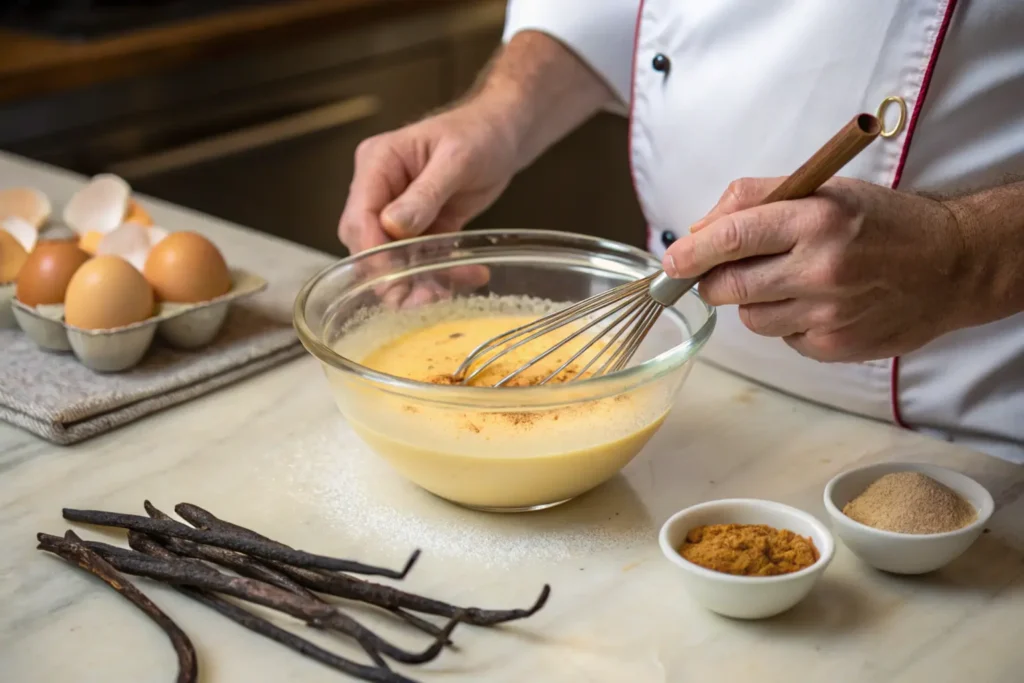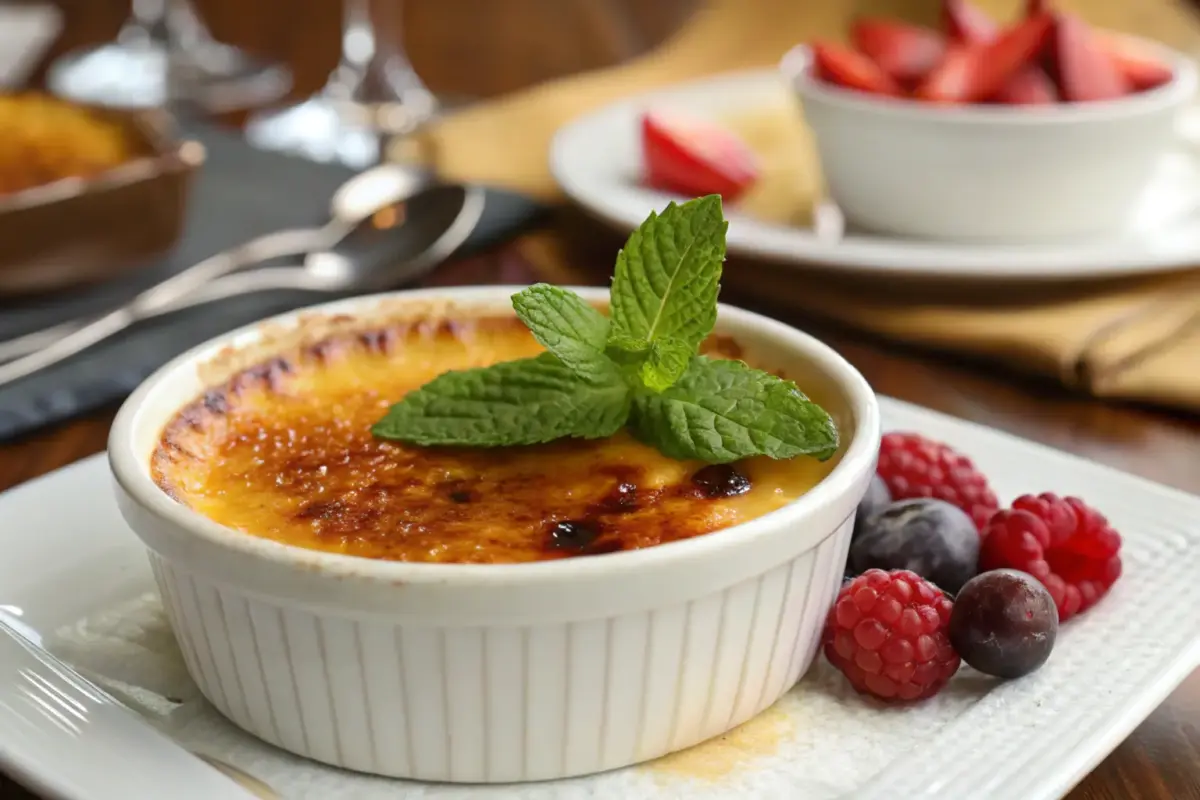Introduction to Crème Brûlée
Crème brûlée, an iconic dessert cherished across cultures, exemplifies the beauty of simplicity combined with refinement. With its silky custard base and crisp caramelized sugar topping, this dessert delivers a perfect harmony of textures and flavors. However, while its presentation may seem intricate, its ingredients are surprisingly straightforward. To truly appreciate its timeless appeal, it is essential to explore what crème brûlée is made of and the artistry behind its preparation.
Historically, crème brûlée has enchanted food lovers for centuries, finding its way from royal courts to modern dining tables. Moreover, its universal appeal lies not just in its taste but also in its adaptability. Whether served as a traditional recipe or infused with creative flavors, it continues to captivate dessert enthusiasts worldwide.
Transitioning from the kitchen to the table, crème brûlée is as much about the sensory experience as it is about taste. The sound of the spoon cracking the caramelized sugar layer is as satisfying as the creamy custard beneath it. Additionally, its versatility makes it a favorite among home cooks and professional chefs alike.
Ultimately, crème brûlée’s enduring charm lies in its ability to transform simple ingredients—heavy cream, eggs, sugar, and vanilla—into an elegant masterpiece that transcends time and trends.
A Brief History of Crème Brûlée
The history of crème brûlée stretches back to at least the 17th century, with its origins often debated among culinary historians. Early records indicate it first appeared in French cuisine, though some argue for its roots in Spanish and English kitchens. This dessert was once served in royal courts, highlighting its prestigious beginnings. Over time, its popularity grew as it became a staple in fine dining establishments worldwide.
The Origin of the Name
The name “crème brûlée” directly translates to “burnt cream” in French, referencing the signature caramelized sugar layer. This topping is traditionally achieved by sprinkling sugar on the custard and using a torch or broiler to create a crisp, golden-brown crust. The simplicity of its name reflects the elegance of the dessert itself. Interestingly, similar desserts in different countries have distinct names, showcasing how crème brûlée’s ingredients inspired adaptations.
Popularity Across the Globe
Crème brûlée’s popularity transcends borders, appearing on menus in a wide array of countries. In France, it’s celebrated as a traditional favorite, while in the United States, it often serves as a hallmark of upscale dining. Variations like crema catalana in Spain and burnt cream in England offer regional twists on this classic. Regardless of its form, its creamy custard and caramelized topping remain beloved by dessert enthusiasts everywhere.
Essential Ingredients for Crème Brûlée
Crème brûlée is a testament to how simple ingredients can yield extraordinary results. The base components—heavy cream, egg yolks, sugar, and vanilla—create a dessert that is both indulgent and versatile. These ingredients work harmoniously to produce its distinct texture and flavor. Let’s explore what crème brûlée is made of in more detail.
Heavy Cream: The Foundation
Heavy cream serves as the foundation of crème brûlée, providing its rich and creamy base. Its high-fat content ensures a smooth and luxurious texture. The cream is gently heated, often infused with flavors like vanilla, to form the custard’s base. Without heavy cream, the dessert would lack its signature richness.
Egg Yolks: Creating the Custard Texture
Egg yolks are essential in achieving the custard-like consistency of crème brûlée. Their proteins thicken the mixture when gently cooked, creating a smooth and silky texture. The number of yolks used can significantly affect the custard’s density, with more yolks yielding a firmer texture. Together with heavy cream, they form the heart of the dessert.
Sugar: Sweetness and Caramelization
Sugar serves two critical roles in crème brûlée. First, it sweetens the custard, balancing the richness of the cream and eggs. Second, it creates the iconic caramelized topping. A thin layer of sugar is sprinkled on top of the custard and exposed to intense heat, resulting in a crunchy, glass-like crust. This contrast between the creamy base and crispy topping defines the dessert.
Vanilla: The Key Flavor Profile
Vanilla is the soul of crème brûlée, lending a warm and aromatic flavor to the custard. Traditional recipes use vanilla beans, which are split and scraped to release their seeds. Alternatively, high-quality vanilla extract can be used for convenience. This ingredient enhances the dessert’s depth, complementing the other components beautifully.
Optional Variations and Enhancements
While the classic version of crème brûlée remains universally loved, creative variations can elevate this dessert to new heights. Many chefs incorporate bold flavors such as citrus zest, chocolate, or coffee directly into the custard to create unique taste profiles. Some home cooks experiment with substituting vanilla for options like lavender, matcha, or cardamom to bring exciting twists to the dessert. Additionally, flavored sugars, such as cinnamon or brown sugar, add depth to the caramelized topping.
Instead of sticking to traditional ingredients, adventurous cooks can swap heavy cream with coconut cream or almond milk to create dairy-free versions. Similarly, the custard base can include seasonal fruits or liqueurs for a personalized touch. Infusions like Earl Grey tea or chai spices can also enhance the custard’s richness while maintaining its creamy texture.
Moreover, presentation plays a significant role in creating variations. Serving crème brûlée in unique ramekin shapes or pairing it with complementary elements like fresh berries or a side of shortbread can elevate the dessert’s appeal. These creative adjustments ensure that the question of what crème brûlée is made of remains open to endless interpretations while preserving its fundamental essence.
How to Prepare Crème Brûlée

Creating crème brûlée at home is a rewarding experience that allows you to appreciate its rich texture and caramelized topping even more. Though its luxurious taste may suggest complexity, preparing this dessert is straightforward if you follow the steps carefully. Here’s a detailed guide to help you master this classic dessert.
Step-by-Step Preparation Process
- Gather the Ingredients: Assemble heavy cream, egg yolks, sugar, vanilla, and any optional flavors.
- Heat the Cream: Warm the heavy cream with vanilla until it’s just below boiling.
- Whisk the Yolks and Sugar: Combine the egg yolks and sugar in a bowl until they are pale and smooth.
- Temper the Eggs: Gradually add the warm cream to the yolk mixture, whisking constantly to avoid curdling.
- Strain the Mixture: Use a fine sieve to remove any solids for a silky custard.
- Fill Ramekins: Pour the custard into ramekins and place them in a baking dish.
- Bake in a Water Bath: Add hot water to the dish, reaching halfway up the ramekins, and bake at 325°F (160°C) until the custard is set.
- Cool and Chill: Let the custard cool, then refrigerate for at least 4 hours.
- Caramelize the Sugar: Before serving, sprinkle sugar on top and caramelize using a torch or broiler.
Tips for Perfecting the Texture
- Use fresh, high-quality ingredients for the best results.
- Do not overheat the cream; it should be warm, not boiling.
- Whisk gently to avoid incorporating too much air, which can cause bubbles in the custard.
- Monitor the baking time closely—overcooked custard will lose its creamy consistency.
- Chill thoroughly before caramelizing the sugar for the ideal temperature contrast.
Equipment and Tools Needed
- Ramekins for baking individual portions.
- A torch or broiler for caramelizing the sugar.
- A fine mesh strainer for a smooth custard.
- A baking dish for the water bath.
- A whisk and mixing bowls for combining ingredients.
Nutritional Information
While crème brûlée is an indulgent treat, understanding its nutritional content helps you enjoy it mindfully. Below is a breakdown of its calories and nutrients.
Calorie Breakdown
A typical serving of crème brûlée (about 4 oz) contains approximately 250–300 calories, depending on the recipe. The calories primarily come from its rich ingredients: heavy cream, egg yolks, and sugar.
Macronutrients and Key Vitamins
- Fat: Most of the fat content comes from the heavy cream, providing around 20 grams per serving.
- Protein: Egg yolks contribute around 4–6 grams of protein.
- Carbohydrates: The sugar adds roughly 20 grams of carbs, mainly from the custard and caramelized topping.
- Vitamins: Crème brûlée is a good source of vitamin A and calcium due to the cream and eggs.
Frequently Asked Questions About Crème Brûlée
What Makes Crème Brûlée Different from Flan?
Crème brûlée differs from flan because it offers a richer texture and a caramelized sugar crust instead of a liquid caramel topping. The custard in crème brûlée feels creamier, while flan tends to have a firmer, gelatin-like consistency.
Can Crème Brûlée Be Made Without Dairy?
Yes, you can prepare crème brûlée without dairy by replacing heavy cream with alternatives such as coconut cream, almond milk, or cashew cream. These substitutes provide a similar richness and flavor, though the taste will slightly differ depending on the alternative used.
Is Crème Brûlée Gluten-Free?
Crème brûlée is naturally gluten-free because its ingredients do not include wheat or gluten-containing products. However, you should always check for cross-contamination or any additional flavorings that might include gluten.
What Type of Sugar Works Best for the Topping?
Granulated sugar works best for caramelizing because it melts evenly and creates the ideal crisp crust. For those seeking a quicker process, superfine sugar also performs well and caramelizes more rapidly.
Can You Make Crème Brûlée Without a Torch?
Yes, you can achieve caramelization without a torch by using an oven broiler. Place the ramekins under the broiler for one to two minutes, monitoring them closely to avoid burning the sugar. This method ensures a caramelized topping without specialized equipment.
Conclusion
Crème brûlée demonstrates how simple, high-quality ingredients can come together to create a timeless dessert enjoyed across the globe. By exploring what crème brûlée is made of, you can better appreciate its creamy custard, crisp caramelized topping, and the craftsmanship involved in its preparation. The core components—heavy cream, egg yolks, sugar, and vanilla—work in harmony to produce a treat that feels both indulgent and elegant.
Preparing crème brûlée, although requiring some attention to detail, offers a rewarding culinary experience. Carefully heating the cream, tempering the eggs, and caramelizing the sugar ensure the perfect combination of flavors and textures. Additionally, experimenting with variations, such as incorporating different flavors or dietary adjustments, allows for a personalized twist on the classic recipe.
This dessert, while indulgent, can fit into a balanced lifestyle when enjoyed in moderation. Its adaptability makes it suitable for diverse dietary needs, including dairy-free or gluten-free options. Whether served in its traditional form or enhanced with creative touches, crème brûlée retains its universal appeal.
Ultimately, crème brûlée symbolizes the perfect blend of simplicity and sophistication. By mastering this dessert, you not only create a dish but also craft an unforgettable culinary experience to share with others.


1 thought on “What is crème brûlée made of?”